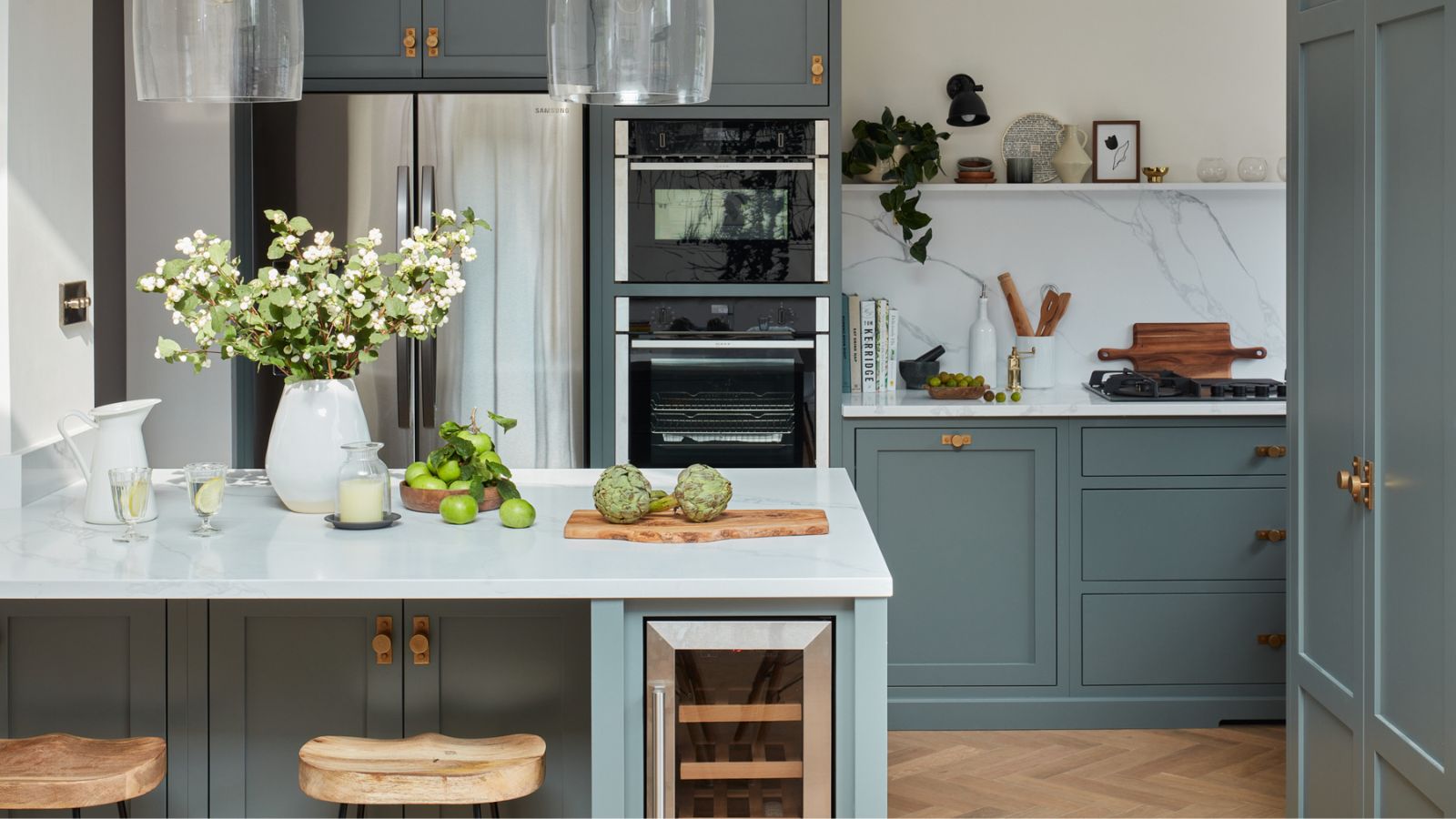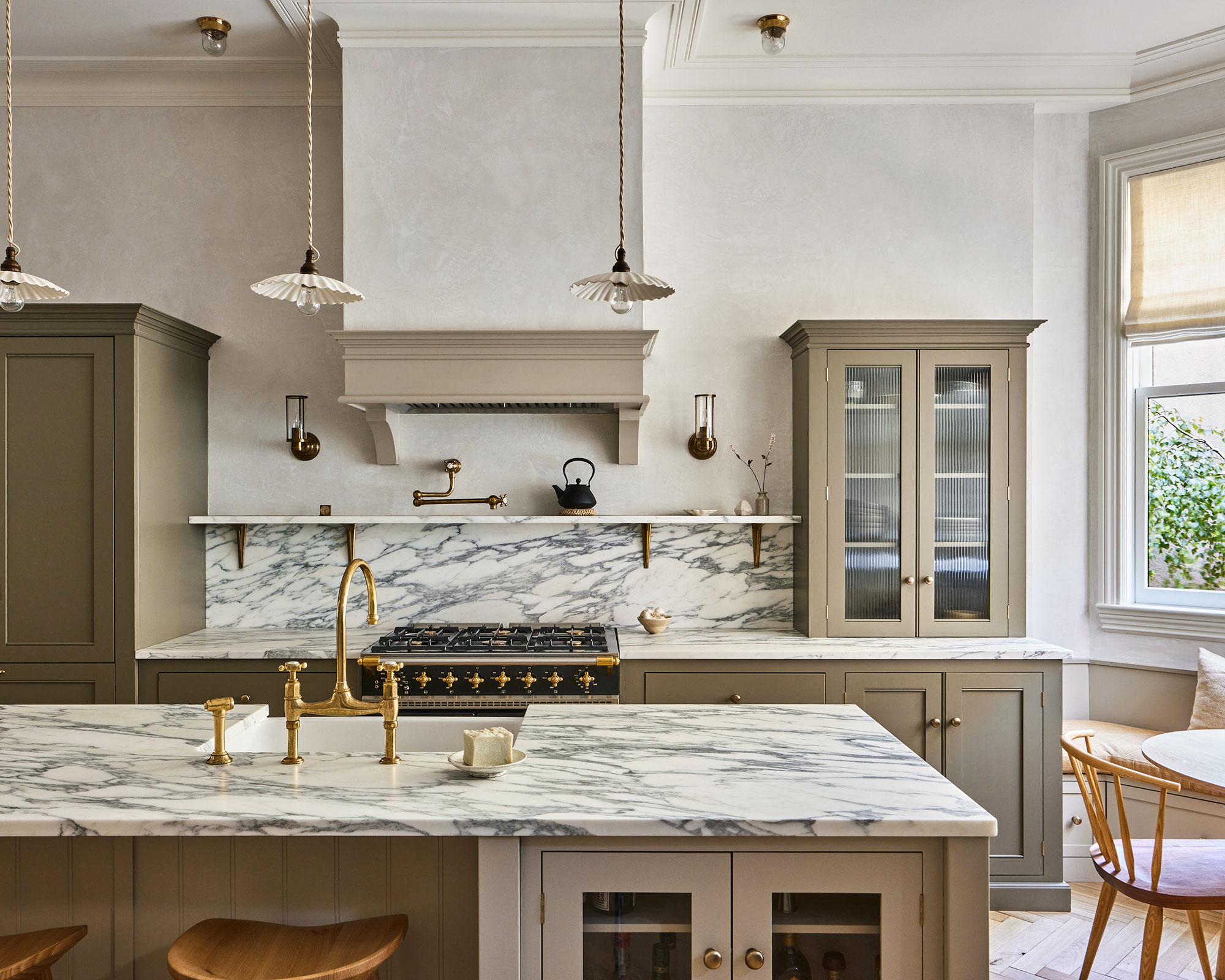
Painted cabinets are a great way to revamp your kitchen on a budget, however, it does make it marginally more difficult to keep your kitchen clean.
You're not only wiping away surface dust when cleaning this area, but tackling bacteria and sticky grease that has built up while cooking – a task that can easily damage your paintwork if done incorrectly.
When cleaning kitchen cabinets you have previously painted, our cleaning experts recommend these four steps to break down tough layers of grease easily without messing up the painted finish.
Cleaning painted cabinets without damaging them
When cleaning a kitchen with painted cabinets, it is essential to use a soft touch and no strong abrasive or chemical cleaners. Even sealed painted cabinets will suffer when subjected to an astringent cleaning solution, says James King, operations manager at Deluxe Maid.
‘Stay away from abrasive stuff,' he says. 'Stick to using soft cloths or sponges, and avoid rough cleaners or scrubbing pads that could mess up your paint.'
It is better to go in with gentle DIY cleaning solutions regularly to stay on top of grease before it builds up and risks damaging your cabinets.
Here's what you'll need:
- A soft microfiber cloth
- Mild soap, such as Dawn dish soap, at Walmart
- Distilled white vinegar, also at Walmart
- A lint-free towel
- A bowl
- Distilled water

Step 1: Remove dust and loose debris
A common dusting mistake is forgetting to dust with a dry cloth before using a wet cleaning solution. Not doing so will mean the dust is moved around and smeared across your cabinet front, rather than being brushed off and away from the surface.
When dusting kitchen cabinets use either a dry, clean microfiber cloth or use a Damp Duster to help pick up loose debris easily. Remember to pay close attention to any small ridges and hardware on the cabinets where dust commonly accumulates unnoticed.
The Damp Duster is great for allergy sufferers as it removes all dust, pollen, pet hair, and more, affordable, reusable, and conveniently sized, and, better yet, is easy to clean – simply rinse the sponge with water to remove dust and grime.
Step 2: Wipe down with a soap solution
After dusting, clean painted cabinets with a mixture of mild dish soap and warm water, avoiding strong commercial cleaners that could strip away the paint.
Ken Doty, cleaning expert and COO at The Maids says, ‘We recommend mixing about one to two teaspoons of dish soap with warm water in a bowl. Soak a soft microfiber rag in the soap solution, squeeze it out so it's moist but not dripping, and gently clean the cabinet surfaces. Focus more on greasy areas, like around the handles and near the cooktop.
‘Test your solution and material on a non-visible part of the cabinet to ensure there's no damage. Then finish by wiping the cabinets with a clean, slightly wet microfiber cloth to remove any leftover soap.’
Step 3: Clean stains carefully with vinegar
If your cabinets are badly stained or have a tough sticky build-up on them, you can try cleaning with vinegar, suggests Eliana Coca, professional cleaner and owner of E.C. House Cleaning. To avoid damaging the paintwork, remember to dilute the vinegar with equal parts water, Eliana advises.
‘Dampen a clean microfiber cloth and gently wipe the cabinet to remove grease and grime,' she says. ‘For stubborn stains, make a paste from baking soda and vinegar and let it sit for five to 10 minutes before rinsing.'
Step 4: Dry with a lint-free towel
Much like cleaning wood cabinets, you need to dry your painted cabinet's front after cleaning to avoid water marks and staining, reminds James King, operations manager.
He says, ‘Get another fresh cloth again to buff away any leftover moisture. If you’re in a hurry, place a fan nearby or open a window to let your cabinets air dry completely. Don’t close the cabinet doors or drawers until everything is totally dry to prevent any moisture from building up inside.'
FAQs
How can I keep my painted cabinets clean?
Painted cabinets look their best when they are cleaned regularly - around once a week - preventing tough build-up that requires harsh scrubbing to remove.
As with any spill or stain, it is best to clean any mark off of painted cabinets as soon as you spot it, says James King, operations manager. ‘When you spill something, just deal with it right away. It’ll save you from having to do a big cleaning session later on.'
You can also run your extractor hood when cooking and for a few minutes after to help draw greasy, damp air up and away from your kitchen cabinets. This will help keep painted cabinets cleaner for longer, and reduce how often you need to touch up the paintwork.
Do painted cabinets need more cleaning?
Painted cabinets need more upkeep than other cabinet finishes. To keep the paint looking its best, Jason Lamprey, seasoned construction expert and owner of Lamprey Construction recommends refinishing kitchen cabinets to refresh the protective sealant.
‘Seal cabinets with wax, polish, or lacquer every six to 12 months. This protects paint from damage, and stains and extends cabinet life. Limit heat and sun exposure when possible. For the best results, use a product specifically recommended for your cabinet's paint finish.'
Now your painted kitchen cabinets are clean and the paint still intact, consider wrapping your kitchen countertops for a quick, easy and budget-friendly makeover.







